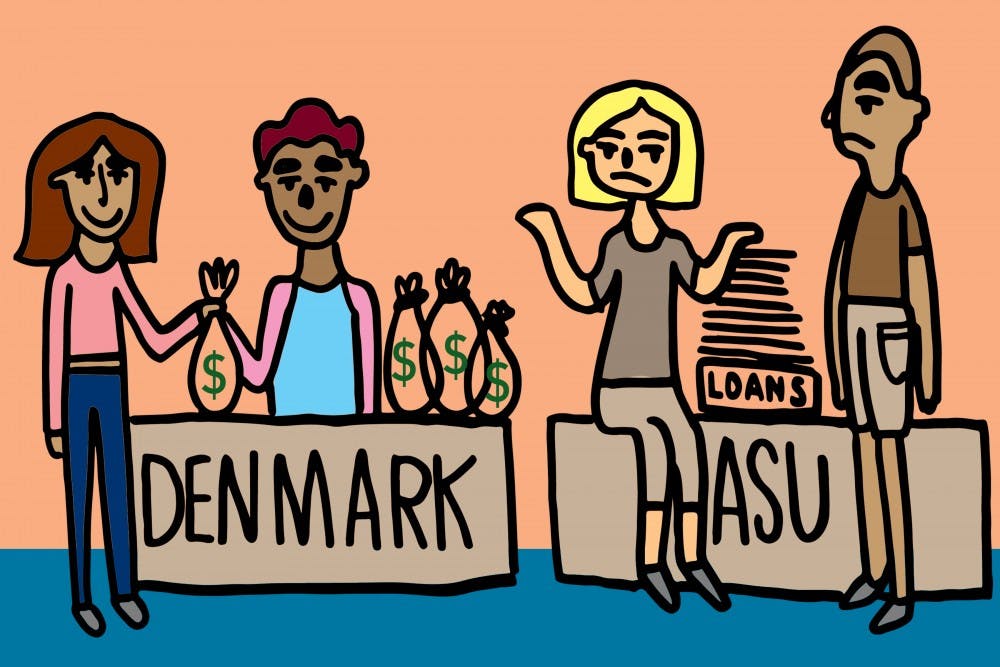Each semester begins with the same ritual — I pick up my student loan from the mailbox, drive to ASU and hand it all over. As my classes pile up, my student loans do as well. It is dispiriting to know that after I graduate, my diploma will be accompanied with immense debt.
My situation is a reality for many students in the U.S. However, it doesn’t have to be this way, and in some countries such as Denmark, it is quite the opposite.
Denmark has some of the highest taxes in the world, but in return it has many social programs that help the community, including free tuition for higher education.
The average personal income tax rate in Denmark is currently 55.8 percent, but it has fluctuated from 55.4 percent to 65.9 percent in recent years, according to Trading Economics. Denmark also has a value added tax or sales tax of 25 percent.
Not only is tuition “free” for the Danes, but depending on different factors such as family income levels, age and school, the Danish government gives a monthly grant of around $430 to $860 to students who do not live with their parents. Students living with their parents usually receive a slightly smaller amount.
“I don’t really have to think about the [financial] worry that I hear other people have from other countries,” said Sofie Amaile Raun, Danish student at Copenhagen Business School. “It’s a really nice system because it allows people not to be defined by how much their family earns or if their parents were able to save up for education.”
The grant goes toward helping students with daily living expenses such as rent, books and food. Students receive the monthly allowance for up to six years and do not have to pay it back. Despite receiving this grant, many Danish students still work part time.
“There are definitely more [people] who get a good education because it’s free and don’t have to think about the costs, but it is also the way it is presented,” Raun said. The Danish government encourages higher education through initiatives such as bonuses for people who graduate early.
As a result of government initiatives, Danish students do not have the financial anxiety that many students in the U.S. have. The total U.S. student debt is at $1.2 trillion, and the average debt for a 2014 graduate is $33,000.
According to the U.S. Department of Education, at Arizona State University 45 percent of students receive loans, and students leave college with an average debt of $20,229. Being burdened with debt is not a good way for a young, educated person to start his or her career.
No one likes paying taxes, but they are necessary to fund things that the community needs and that can’t be financed individually. Policymakers at the state and national levels should not be worrying about how much to cut taxes, but by how much they should be raising them.
Having an attainable “free” education incentivizes getting a degree. More educated people create a stronger workforce, which means more people in higher paying jobs, more people with higher disposable incomes and more money being spent, creating a stronger economy.
Denmark is a small, democratic-socialist country with a rather homogeneous population. However, they are doing something right — they are looking after the well-being of their citizens. If this means having higher taxes to offset the cost of education, then I think it is an option that should be considered by policymakers in the U.S.
I am not saying we should change our taxation system to mirror that of Denmark, but I am saying a developed nation such as the U.S. is not being as progressive as we should be. We need to be investing in our people, especially in our youth who are seeking education, but may not have the funds to do so.
“In Denmark, we say that everyone has a right to education, which means you don’t get defined by your background," Raun said.
The issue of funding higher education was reexamined during the 2016 Presidential election, and many saw hope in restructuring our failed system. Although this is currently not a main concern for President Donald Trump, examining successful systems from around the world can be a step toward finding a solution that is best fit for the U.S.
Reach the reporter at hehillst@asu.edu or follow @hollyhillsten on Twitter.
Editor’s note: The opinions presented in this column are the author’s and do not imply any endorsement from The State Press or its editors.
Want to join the conversation? Send an email to opiniondesk.statepress@gmail.com. Keep letters under 300 words and be sure to include your university affiliation. Anonymity will not be granted.
Like The State Press on Facebook and follow @statepress on Twitter.




